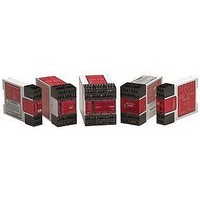EM-T-7A BANNER ENGINEERING, EM-T-7A Datasheet - Page 4

EM-T-7A
Manufacturer Part Number
EM-T-7A
Description
Extension Module; Relay; Red LED; 24; DIN Rail; UL listed
Manufacturer
BANNER ENGINEERING
Specifications of EM-T-7A
Light Source
Red LED
Mounting
DIN Rail
Output Type
Relay
Standards
UL listed
Voltage, Supply
24 VAC⁄VDC
Coil Voltage Vdc Nom
24V
Contact Current Max
6A
Contact Voltage Ac Nom
250V
Contact Voltage Dc Nom
250V
Contact Configuration
DPDT-NO
No. Of Poles
2
Relay Mounting
DIN Rail
External Height
84mm
Lead Free Status / Rohs Status
RoHS Exempt Product
Extension Module –
Model EM-T-7A Extension Module is driven by one or two safety output channels of a
Primary Safety Device. The design of the Primary Safety Device must meet OSHA and
ANSI control reliability requirements. The EM-T-7A must be used ONLY with Primary
Safety Devices which have a dedicated input for feedback monitor contacts (see hookup
diagrams).
Each output channel of the Primary Safety Device must meet the following
requirements:
• Include two (or more) redundant, normally open forced-guided (positive-guided)
• Be self-monitored to result in a safe (open) condition in the event of a contact failure,
• Be capable of switching 30 to 250 mA at 13 to 28V dc.
The model EM-T-7A Extension Module must be installed inside an enclosure. It is not
designed for exposed wiring. It is the user’s responsibility to house the Extension Module in
an enclosure with NEMA 3 (IEC IP54) rating, or better.
Dimensions of the Extension Module are shown in Figure 2; it mounts directly to standard
35mm DIN rail.
As the Extension Module can be used with many different Primary Safety Devices and can
interface to a multitude of machine control configurations, it is not possible to give exact
wiring instructions for the output contacts. The following guidelines are general in nature.
The output contacts of the Extension Module have no delay function. They will open within
20 milliseconds from the time that the controlling contacts coming from the Primary
Safety Device open.
IMPORTANT: Review the following discussion of one-channel and two-channel control
page
Primary Safety Device Requirements
Mechanical Installation
Electrical Installation
contacts,
and
4
before connecting the Extension Module to its Primary Safety Device.
Model EM-T-7A
Installation
Banner Engineering Corp. • Minneapolis, U.S.A.
Website: http://www.baneng.com • Tel: 888.373.6767
1) DO NOT connect E-stop switches,
2) ALWAYS connect terminals Y1 and Y2
This Extension Module does not have the
circuitry required to perform a self-check. A
single fault inside the unit or in external
devices like switches or E-Stop buttons
connected to the unit can go undetected
and create an unsafe condition. Failure to
properly connect this Extension Module to
a control-reliable Primary Safety Device
could result in serious injury or death.
Always disconnect all power from the
Extension Module, the Primary Safety
Device, and from the machine being
controlled before making any wire
connections. Electrical installation and
wiring must be made by qualified
personnel and must comply with the NEC
(National Electrical Code), EN 60204-1
and -2, and all applicable local standards
and codes.
2-hand-control switches, safety
interlock switches, or similar devices
directly to this Extension Module.
of this Extension Module to the
monitoring input of the Primary
Safety Device that controls it (see
Figure 3).
!
CAUTION . . .
Dangerous Voltages
WARNING . . .
Use As a Stand-Alone
Safety Relay
Not for











